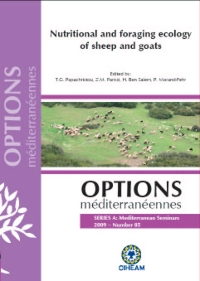| Article précédent | p. 171-176 | Article suivant |
Small ruminants as manipulators of brown hare (Lepus europaeus) habitat in kermes oak rangelands
Livestock grazing affects habitat structure and forage resources, thus it often influences the abundance and dispersion of wild fauna's populations. The aim of this study was to assign the usefulness of small ruminants as habitat manipulators for brown hare in a mosaic landscape (kermes oak stands intermingled with grasslands). The importance of kermes oak as a food resource for goats and sheep in spring was estimated with the microhistological analysis of faeces. We also tested the hypothesis that different levels of livestock grazing intensity influence the use of kermes oak stands by hare; and the type of habitat (kermes oak stands or grasslands), which is used more intensively by hares, using the pellet counts method. Kermes oak was a primary food resource for goats and a secondary one for sheep. Different levels of livestock grazing intensity did not affect the use of kermes oak stands by hare. Grasslands constituted the main feeding habitat for hare, while kermes oak stands were used mainly for shelter. Reducing the scrubland area and creating various shaped and sized openings (grasslands) could benefit brown hares. However, available cover and food must both be considered in conservation plans. Manipulation of kermes oak stands can be based mainly on goats and secondarily on sheep. Grazing strategies may be used to increase forage availability for hare, to improve its quality and to provide adequate cover, so as to attract hares to desired areas. Thus, under appropriate grazing management brown hare habitat values could be enhanced.
Le pâturage affecte la structure de l'habitat et les ressources fourragères ; ce qui influence l'abondance et la dispersion des populations de la faune sauvage. L'objectif de cette étude est de démontrer l'utilité des petits ruminants comme manipulateurs de l'habitat du lièvre marron dans un paysage en mosaïque (association de chêne kermès et d'herbacées). L'importance du chêne kermès comme aliment pour les caprins et les ovins au printemps a été estimée par analyse micro-histologique des fèces. On a aussi testé l'hypothèse selon laquelle différents niveaux d'intensité de pâturage affectent l'utilisation du chêne kermès par le lièvre, et le type d'habitat (bosquets de chêne kermès ou de prairie), qui est utilisé plus intensivement par les lièvres, en utilisant la méthode de comptage des crottes. Le chêne kermès représente le principal aliment chez les caprins et l'aliment secondaire pour les ovins. Les différents niveaux d'intensité de pâturage n'ont pas affecté l'utilisation des bosquets de chêne kermès par le lièvre. La végétation herbacée constitue la principale source d'alimentation du lièvre, alors que le chêne kermès a été utilisé par cet animal comme abri. La réduction de la superficie du maquis et la création de différentes formes et d'ouvertures dimensionnées (prairies) pourraient être avantageuses pour le lièvre marron. Néanmoins, la couverture et l'alimentation disponible doivent être considérées dans les programmes de conservation. La manipulation des bosquets de chêne kermès pourrait être basée sur les caprins et en second lieu sur les ovins. Les stratégies de pâturage peuvent être utilisées pour augmenter la disponibilité fourragère pour le lièvre, pour améliorer sa qualité et pour assurer une meilleure couverture permettant d'attirer les lièvres dans des endroits ciblés. Par conséquent, moyennant une gestion des parcours appropriée, la valeur de l'habitat du lièvre marron peut être améliorée.
- [ Afficher ]
- [ Télécharger ]
- [ Exporter la citation ]
Vous pouvez télécharger la citation au format :
- [ Imprimer ]
-
Mots-clés
CAPRIN, COUVERTURE VEGETALE, FAUNE, LIEVRE, NUTRITION ANIMALE, OVIN, PATURAGE, PLANTE, PRAIRIE, QUERCUS COCCIFERA, SCRUBCiter cet article
Karmiris I., Nastis A.S. Small ruminants as manipulators of brown hare (Lepus europaeus) habitat in kermes oak rangelands. In : Papachristou T.G. (ed.), Parissi Z.M. (ed.), Ben Salem H. (ed.), Morand-Fehr P. (ed.). Nutritional and foraging ecology of sheep and goats. Zaragoza : CIHEAM / FAO / NAGREF, 2009. p. 171-176. (Options Méditerranéennes : Série A. Séminaires Méditerranéens; n. 85). 12. Seminar on: Nutritional and Foraging Ecology of Sheep and Goats, 2007/10/11-13, Thessaloniki (Greece). http://om.ciheam.org/om/pdf/a85/00801003.pdf



